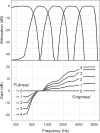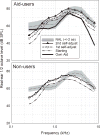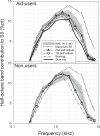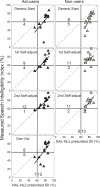A "Goldilocks" Approach to Hearing Aid Self-Fitting: Ear-Canal Output and Speech Intelligibility Index
- PMID: 29894379
- PMCID: PMC6289875
- DOI: 10.1097/AUD.0000000000000617
A "Goldilocks" Approach to Hearing Aid Self-Fitting: Ear-Canal Output and Speech Intelligibility Index
Abstract
Objectives: The objective was to determine self-adjusted output response and speech intelligibility index (SII) in individuals with mild to moderate hearing loss and to measure the effects of prior hearing aid experience.
Design: Thirteen hearing aid users and 13 nonusers, with similar group-mean pure-tone thresholds, listened to prerecorded and preprocessed sentences spoken by a man. Starting with a generic level and spectrum, participants adjusted (1) overall level, (2) high-frequency boost, and (3) low-frequency cut. Participants took a speech perception test after an initial adjustment before making a final adjustment. The three self-selected parameters, along with individual thresholds and real-ear-to-coupler differences, were used to compute output levels and SIIs for the starting and two self-adjusted conditions. The values were compared with an NAL second nonlinear threshold-based prescription (NAL-NL2) and, for the hearing aid users, performance of their existing hearing aids.
Results: All participants were able to complete the self-adjustment process. The generic starting condition provided outputs (between 2 and 8 kHz) and SIIs that were significantly below those prescribed by NAL-NL2. Both groups increased SII to values that were not significantly different from prescription. The hearing aid users, but not the nonusers, increased high-frequency output and SII significantly after taking the speech perception test. Seventeen of the 26 participants (65%) met an SII criterion of 60% under the generic starting condition. The proportion increased to 23 out of 26 (88%) after the final self-adjustment. Of the 13 hearing aid users, 8 (62%) met the 60% criterion with their existing hearing aids. With the final self-adjustment, 12 out of 13 (92%) met this criterion.
Conclusions: The findings support the conclusion that user self-adjustment of basic amplification characteristics can be both feasible and effective with or without prior hearing aid experience.
Figures








References
-
- ANSI/ASA. S3.5-1997 American National Standard Methods for Calculation of the Speech Intelligibility Index R2012
Publication types
MeSH terms
Grants and funding
LinkOut - more resources
Full Text Sources
Other Literature Sources
Medical
Miscellaneous

